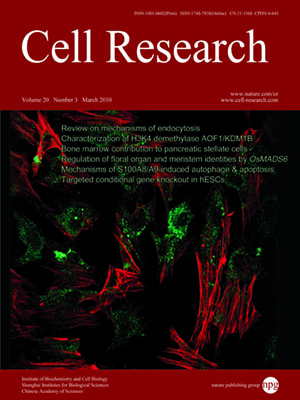
Volume 20, No 3, Mar 2010
ISSN: 1001-0602
EISSN: 1748-7838 2018
impact factor 17.848*
(Clarivate Analytics, 2019)
Volume 20 Issue 3, March 2010: 276-287
ORIGINAL ARTICLES
AOF1 is a histone H3K4 demethylase possessing demethylase activity-independent repression function
Ze Yang1, Jun Jiang2, David M Stewart3, Shankang Qi1, Kenichi Yamane4, Jiwen Li1, Yi Zhang4 and Jiemin Wong1
1The Institute of Biomedical Sciences and School of Life Sciences, East China Normal University, Shanghai 200241, China
2Department of Urology, Daping Hospital/Institute of Surgical Research, Third Military Medical University, Chongqing 400042, China
3Department of Genetics, University of Texas MD Anderson Cancer Center, Houston, TX 77030, USA
4Howard Hughes Medical Institute and University of North Carolina at Chapel Hill, Chapel Hill, NC 27599, USA
Correspondence: Jiemin Wong,(jmweng@bio.ecnu.edu.cn)
LSD1 (KDM1 under the new nomenclature) was the first identified lysine-specific histone demethylase belonging to the flavin-dependent amine oxidase family. Here, we report that AOF1 (KDM1B under the new nomenclature), a mammalian protein related to LSD1, also possesses histone demethylase activity with specificity for H3K4me1 and H3K4me2. Like LSD1, the highly conserved SWIRM domain is required for its enzymatic activity. However, AOF1 differs from LSD1 in several aspects. First, AOF1 does not appear to form stable protein complexes containing histone deacetylases. Second, AOF1 is found to localize to chromosomes during the mitotic phase of the cell cycle, whereas LSD1 does not. Third, AOF1 represses transcription when tethered to DNA and this repression activity is independent of its demethylase activity. Structural and functional analyses identified its unique N-terminal Zf-CW domain as essential for the demethylase activity-independent repression function. Collectively, our study identifies AOF1 as the second histone demethylase in the family of flavin-dependent amine oxidases and reveals a demethylase-independent repression function of AOF1.
Cell Research (2010) 20:276-287. doi: 10.1038/cr.2010.12; published online 26 January 2010
FULL TEXT | PDF
Browse 2230


